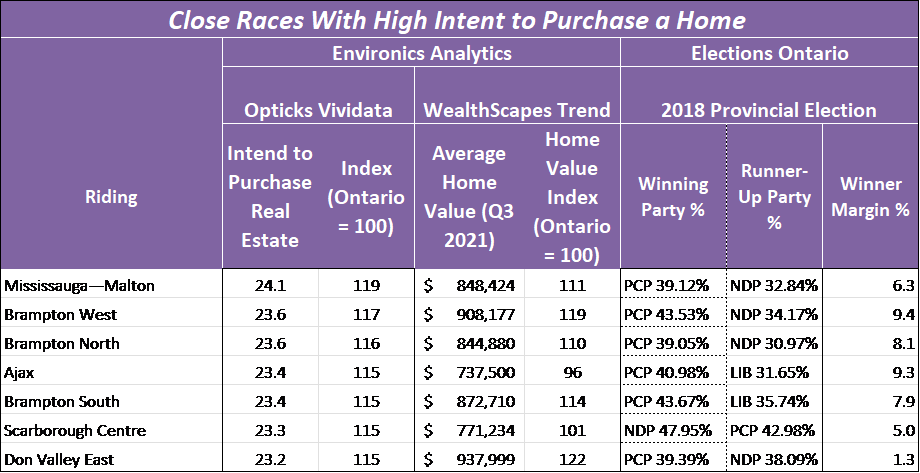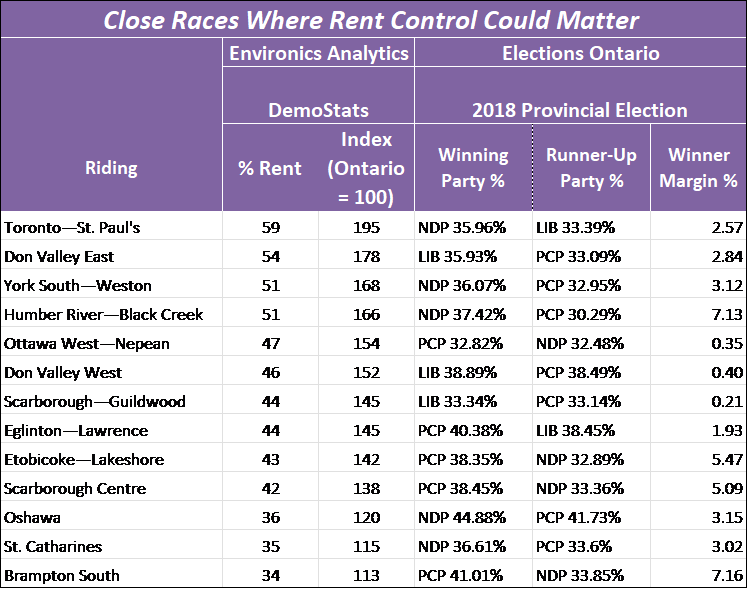Housing and rental policies could sway key Ontario ridings, data suggests
Ontario’s political parties may be able to sway some voters in ridings that were close calls in 2018 based on their housing affordability and rent control policies.
According to data provided by Environics Analytics, about 12 per cent of Ontario households intend to buy real estate in the next year.
According to Senior Vice President Rupen Seoni, the voting populations that have said they intend to purchase property are suburban households in the Greater Toronto Area and Ottawa, as well as smaller city suburban families and Ontarians living in neighbourhoods with large concentrations of newer Canadians.
All three of these voter groupings voted primarily Progressive Conservative in 2018.
“While home prices in these areas are not low, they are not the most expensive parts of the province,” he said.
Voters living in ridings with the lowest home values were also least likely to be interested in buying a home.
 This chart shows the ridings with a high intent to purchase a home. (Environics Analytics)
This chart shows the ridings with a high intent to purchase a home. (Environics Analytics)
Seoni identified six “close races” from the last provincial election in which voters had a high intent to purchase a home. The PCs won all but a single riding.
“If housing market proposals by the parties are received well, the one in four residents who say they intend to purchase might be up for the taking in these ridings,” he said.
All four major political parties have made big housing pledges, promising to build hundreds of thousands of new homes in the next 10 years if elected.
- Platform guide: What are the political parties promising?
The Ontario New Democratic Party, on the other hand, appears to have a slight upper hand among renters, who are primarily made up of younger and newcomer voters.
“Rent control promises could help the NDP hang on to more votes in these segments,” Seoni said.
Both the Ontario NDP and Liberals have pledged to reintroduce rent control. Currently, annual rent increases are slightly regulated in Ontario to align with the Ontario Consumer Price Index; however this does not apply to newer buildings constructed after 2018 or in a scenario in which a unit is vacant.
The Liberals would make it so that landlords could only raise rent at a set rate each year during a lease while the NDP have promised to prevent landlords from charging more for rent between leases, preventing landlords from jacking up rent between leases.
 Close call ridings where a large population rents their home. (Environics Analytics)
Close call ridings where a large population rents their home. (Environics Analytics)
Of 13 close races from 2018—in which a riding was won by under 10 percentage points—Environics Analytics found that all but two were located in and around Toronto.
“Renters make up at least one third, and in a few cases, over half of households. So high rents will be on many of these residents’ minds,” Seoni said. “Five of these ridings went to the PCs with slim margins.”
Seoni adds that if renters can be mobilized, the PCs would be most vulnerable in Ottawa West-Nepean, Eglinton-Lawrence, Etobicoke-Lakeshore, Scarborough Centre and Brampton-South.
Can't see the map? Click here.
CTVNews.ca Top Stories

Sparks fly as MPs question minister on pension implications of proposed election date change
Sparks flew at a parliamentary committee Thursday as MPs questioned Canada's democratic institutions minister about a widely opposed provision in electoral reform legislation that seeks to delay the next fixed election date by one week.
'There is no electricity': Canadian travellers in Cuba urge caution in hurricane's wake
Cuba's power grid was knocked out by Hurricane Rafael, which ripped across the country as a Category 3 storm. In western Cuba, it toppled buildings and pushed 50,000 people to find shelter elsewhere. Cubans were already enduring rolling blackouts due to energy shortages.
Three charged in One Direction singer Liam Payne's death
Three people have been charged in relation to One Direction singer Liam Payne's death in a fall from his Buenos Aires hotel balcony last month, Argentine authorities said on Thursday.
RCMP already 'on high alert' for potential wave of migrants after Trump election
Canada's federal police force has been preparing for months on a contingency plan for a potential massive influx of migrants across the border following Trump's promise of 'mass deportations' of millions of undocumented immigrants in the U.S.
'There was no stopping this baby from coming': Woman gives birth while aboard Newfoundland ferry
A young family from Codroy Valley, N.L., is happy to be on land and resting with their newborn daughter, Miley, after an overwhelming, yet exciting experience at sea.
Volkswagen models recalled for airbag safety precaution
Recall notices have been issued for some Volkswagen models from 2006 to 2019 for airbag safety issues.
Canmore wildlife and landscape defender Karsten Heuer dies peacefully at 56
Canmore conservationist Karsten Heuer, who was a biologist, park ranger, author and activist, has died.
America votes: How celebrities are reacting to Trump's decisive victory
Celebrities from Hulk Hogan to Ariana Grande are sharing their reactions to the U.S. election, which will see Donald Trump return to the White House.
3 Winnipeg police officers charged with breach of trust, theft
Three members of the Winnipeg Police Service have been charged with breach of trust, obstruction of justice and theft following a lengthy investigation

































